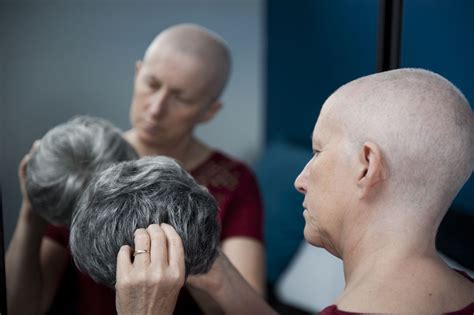Introduction

Cancer treatment can involve chemotherapy and radiation therapy, which often lead to hair loss. This can be a difficult and emotional experience for patients. Wigs can provide a sense of normalcy, confidence, and support during this challenging time. This comprehensive guide explores the various types, benefits, and considerations when choosing a wig for cancer patients.
Types of Wigs for Cancer Patients
1. Synthetic Wigs:
- Made from synthetic fibers such as acrylic or nylon
- Affordable and easy to style
- Available in a wide range of colors and textures
2. Human Hair Wigs:
- Made from real human hair
- More expensive than synthetic wigs
- Provide a natural look and feel
- Can be styled with heat
3. Capless Wigs:
- No cap construction
- Extremely lightweight and breathable
- Ideal for sensitive scalps
4. Lace Front Wigs:
- Lace foundation along the hairline
- Creates a natural-looking hairline
- Requires regular maintenance and care
Benefits of Wigs for Cancer Patients
- Improved Self-Esteem: Wigs can help restore a sense of identity and confidence.
- Protection from Sun and Cold: Scalps without hair can be sensitive to the sun and cold. Wigs offer protection.
- Privacy and Anonymity: Wigs can provide a sense of privacy and anonymity during treatment.
- Therapeutic Value: The process of choosing and wearing a wig can be therapeutic, providing a sense of control and empowerment.
Considerations When Choosing a Wig
- Medical Condition: Some wigs may be more suitable for patients with certain medical conditions. Consult a healthcare professional for guidance.
- Hair Texture and Color: Choose a wig that closely matches the texture and color of your natural hair, or opt for a different style for a change.
- Comfort and Fit: Wigs should be comfortable to wear for extended periods. Ensure a secure and snug fit without causing irritation.
- Lifestyle Needs: Consider your lifestyle and daily activities when choosing a wig. Choose wigs that are easy to care for and maintain.
How to Choose the Right Wig
1. Start with Research:
- Visit specialized wig stores or websites
- Read reviews and testimonials from other cancer patients
- Consider consulting a hair stylist or wig specialist
2. Determine Your Budget:
- Wigs range in price depending on the type, material, and style
- Determine a budget that aligns with your needs and financial situation
3. Try On Different Wigs:
- Visit a wig store and try on different types and styles
- Take your time and explore various options until you find a wig that feels comfortable and confident
- Bring a friend or family member for support and feedback
4. Maintenance and Care:
- Synthetic wigs require minimal care (shampooing and conditioning)
- Human hair wigs require more frequent maintenance (styling, conditioning, and regular washes)
- Follow the manufacturer’s instructions for proper care
Insurance Coverage for Wigs
In some countries, insurance may cover the cost of wigs for cancer patients. Check with your insurance provider to determine eligibility and coverage details.
Tips for Wearing a Wig
- Secure the Fit: Use wig tape or clips to secure the wig
- Style Naturally: Avoid over-styling or using excessive products
- Protect from Damage: Store the wig in a cool, dry place when not in use
- Clean Regularly: Wash the wig as per the manufacturer’s instructions
- Seek Support: Join support groups or connect with other cancer patients who have worn wigs
Tables for Reference
Table 1: Types of Wigs
| Type | Material | Benefits |
|---|---|---|
| Synthetic | Acrylic or Nylon | Affordable, Easy to Style |
| Human Hair | Real Human Hair | Natural Look and Feel, Heat-Stylable |
| Capless | No Cap Construction | Lightweight, Breathable |
| Lace Front | Lace Foundation | Natural-Looking Hairline |
Table 2: Benefits of Wigs for Cancer Patients
| Benefit | Description |
|---|---|
| Improved Self-Esteem | Restores Confidence and Identity |
| Protection from Sun and Cold | Protects Scalp from Sensitivity |
| Privacy and Anonymity | Provides Privacy and Anonymity during Treatment |
| Therapeutic Value | Offers Control and Empowerment during Treatment |
Table 3: Considerations When Choosing a Wig
| Consideration | Description |
|---|---|
| Medical Condition | Consult Healthcare Professional for Suitability |
| Hair Texture and Color | Match or Change Hair Style |
| Comfort and Fit | Ensure Comfortable and Secure Wear |
| Lifestyle Needs | Choose Wigs that Meet Daily Activity Needs |
Table 4: Tips for Wearing a Wig
| Tip | Description |
|---|---|
| Secure the Fit | Use Wig Tape or Clips |
| Style Naturally | Avoid Over-Styling |
| Protect from Damage | Store in a Cool, Dry Place |
| Clean Regularly | Follow Manufacturer’s Instructions |
| Seek Support | Join Support Groups or Connect with Others |
Conclusion
Wigs can provide invaluable support and confidence for cancer patients during treatment. By understanding the different types, benefits, and considerations involved in choosing a wig, patients can make informed decisions that cater to their unique needs. Remember, a wig is more than just a hairpiece; it is a symbol of hope, strength, and the beauty that continues to shine through adversity.
